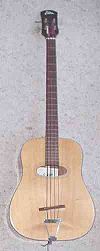Acoustic bass guitar
The acoustic bass guitar (also called ABG or acoustic bass) is a bass instrument with a hollow wooden body similar to, though usually somewhat larger than a steel-string acoustic guitar.History
The first modern acoustic bass guitar was developed in the early 1960s by Ernie Ball of San Luis Obispo, California. Ball's aim was to provide bass guitarists with a more acoustic-sounding instrument that would match better with the sound of acoustic guitars. Ball stated that "...if there were electric bass guitars to go with electric guitars then you ought to have acoustic basses to go with acoustic guitars." Ball notes that "...the closest thing to an acoustic bass was the Mexican guitarron...in mariachi bands, so I bought one down in Tijuana and tinkered with it."[1]
Ball collaborated with George Fullerton, a former employee at Fender, to develop the Earthwood acoustic bass guitar, which was introduced in 1972. Production of this instrument ceased in 1974, resuming a few years later under the direction of Ernie Ball employee Dan Norton, until production finally ended again in 1985. The Earthwood acoustic bass guitar was quite large (and deep) in contrast to most instruments in current production, which gave it more volume, especially in the low register.photo 1photo 2photo 3 The Ernie Ball company describes Ball's design as "an idea before its time"; the instrument was little-used in acoustic musical performances until the late 1980s, when the acoustic basses were used in performances on the MTV Unplugged television program.
Construction and tuning
Unlike the electric bass guitar, which is generally a solid body instrument, the acoustic bass guitar usually has a hollow wooden body similar to (though usually somewhat larger than) that of the steel-string acoustic guitar. The majority of acoustic basses are fretted, but a significant number are fretless instead. Semi-fretted versions also exist, although they are quite rare.

Like the traditional electric bass and the double bass, the acoustic bass guitar commonly has four strings, which are normally tuned E-A-D-G, an octave below the lowest four strings of the 6-string guitar. Like the electric bass guitar, models with five or more strings have been produced, although these are less common. In part, this is because the body of an acoustic bass guitar is too small to produce a resonance of acceptable volume at lower pitches on the low "B" string. One solution uses the five string acoustic bass to add an additional high string ("E-A-D-G-C") instead of adding a low "B". Another solution is to rely on amplification to reproduce the low "B" string's notes.
Because it can be difficult to hear an acoustic bass guitar without an amplifier, even in settings with other acoustic instruments, most acoustic basses have pickups, either magnetic or piezoelectric or both, so that they can be amplified with an instrument amplifier or a Public Address system.
There are also semi-acoustic models fitted with pickups that are intended to be used with an amplifier. The soundbox of these instruments is not large enough to amplify the sound; instead, it is designed to produce a distinctive tone when amplified, similarly to semi-acoustic electric guitars. Thin-body semi-acoustic basses such as the violin-shaped Höfner made famous by the early Beatles and several Fender models are not normally regarded as acoustic basses at all, but rather as hollow-bodied bass guitars. As with semi-acoustic electric guitars, the line between acoustic instruments fitted with pickups and electric instruments with tone-enhancing bodies is sometimes hard to draw.
Saga Musical Instruments produces a four-string bass resonator guitar under their Regal brand name.videos National Reso-Phonic Guitars also produce three models of resonator bass guitar.
Manufacturers
Other manufacturers of acoustic bass guitars (not mentioned above) include Alvarez, Breedlove,Cort, Crafter, Jerzey, Dean, Eston, Gibson, Washburn, Ibanez, Maton, Ovation, Michael Kelly, Prestige Ribbecke Halfling Bass, Sunlite, Takamine, Tacoma and Tanglewood.Mexican bass guitars
Traditional music of Mexico features several varieties of acoustic bass guitars.
The baja sexto, with six pairs of strings, resembles a twelve-string guitar tuned an octave lower. The heavy gauge strings generate a large string tension, yet the guitar is built relatively lightly. The baja sexto began to be used in Texas in the 1920s with the rise of "Tex-Mex" music, where it continues to be used to play the parts which would be played by the piano in traditional American popular music. A Mexican variation of the baja sexto is called bajo sexto. The tuning of these instruments is (capital letters are an octave lower than small letters):
- BAJA SEXTO - Ee Aa Dd Gg Cc Ff
- BAJO SEXTO - Ee Aa Dd gg bb ee
The guitarrón or chitarrone is a very large, deep-bodied Mexican 6-string acoustic bass guitar played in Mariachi bands. Other Latin American acoustic bass guitars exist as well, see: Bordonua Also, since the classical contrabass guitar shares the same range as an ABG, it is a type of acoustic bass guitar.
No comments:
Post a Comment